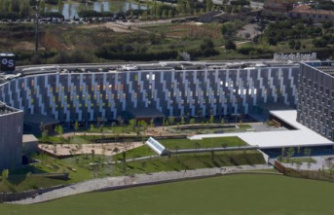Armed protesters took control of the Malheur National Wildlife Refuge headquarters on Jan. 2, but the conflict over federal land management began years before that. Here's how the eastern Oregon standoff started and ended:
2012: Harney County ranchers Dwight Hammond Jr. and son Steven are convicted of arson for setting fires on federal land in 2001 and 2006. A federal judge sentences the elder Hammond to three months and the younger one to one year in prison.
Spring 2014: A 20-year dispute between rancher Cliven Bundy and the U.S. Bureau of Land Management over $1 million in unpaid grazing fees leads to an armed standoff on federally owned land in Nevada.
2015: After an appeals court overturns the Hammonds' original sentences, a federal judge issues new, five-year prison terms to each man, with credit for time already served.
Mid-December: Militants from states across the West begin assembling in the small town of Burns to protest the pending re-imprisonment of the Hammonds over what they describe as unjust federal land policies.
Jan. 1, 2016: Community members meet with the protesters to voice their concerns in advance of a weekend rally.
Jan. 2: After an estimated 300 marchers parade through Burns in support of the Hammonds, a splinter group of armed protesters takes over the headquarters of the Malheur National Wildlife Refuge, about 30 miles south of Burns.
Jan. 3: Ammon Bundy, son of Nevada rancher Cliven Bundy and the leader of the wildlife refuge occupiers, says the group has no intention of violence unless the government acts against them.
Jan. 4: The Hammonds report to federal prison in California but say they will seek clemency from the president. Harney County Sheriff David Ward, during a news conference, tells the occupiers to, "Go home."
Jan. 5: Ammon Bundy says the occupiers won't leave until local property owners have control over the refuge, or if the community shows they're no longer welcome. Ward says law enforcement is taking steps being behind the scenes to end the standoff.
Jan. 6: The Burns Paiute Tribe, which once held land that included the refuge, calls on the militants to end the standoff. A nighttime scuffle between occupiers and an outside group sends one man to the hospital with a black eye.
Jan. 7: The sheriff and Ammon Bundy meet on neutral ground to discuss ending the refuge occupation. Gov. Kate Brown demands that the protesters "decamp immediately."
Jan. 8: Ammon Bundy says the group doesn't plan to leave for now.
Jan. 11: After a week off, schools reopen in Burns. The militants destroy a portion of a U.S. Fish & Wildlife Service fence, saying they received permission from the rancher whose cattle graze on private land adjoining the wildlife refuge.
Jan. 12: The militants say they will reveal their exit plan at a meeting on Friday evening.
Jan. 13: Rancher Tim Puckett says he didn't give the militants permission to destroy a publicly owned fence and is upset about what happened.
Jan. 15: The "exit strategy" meeting doesn't happen over a dispute about where to hold the meeting. Authorities also make their first occupation-related arrest: Kenneth Medenbach, 62, of Crescent was accused of having a stolen vehicle after authorities said he drove a government pickup to Burns.
Jan. 16: Occupiers clash with conservationists during a daily briefing after presenting a pile of surveillance cameras they say were installed by law enforcement.
Jan. 18: The protesters say they've recruited ranchers to stop paying the federal government grazing fees and plan a "signing ceremony" for later in the week. In an evening meeting, they encourage ranchers to tear up their government grazing contracts.
Jan. 19: Conservation groups stage rallies in Portland, Eugene, Bend and La Grande to urge the occupiers to end the standoff. A community meeting in Burns, with Ammon Bundy in attendance, is punctuated by emotional and highly personal remarks.
Jan. 21: Gov. Brown, in a letter to top federal law enforcement officials, asks for "swift resolution" to the occupation. Ammon Bundy and the FBI begin negotiations to end the standoff.
Jan. 22: Negotiations stumble after Bundy questions the FBI's legal authority to operate in Harney County.
Jan. 26: Oregon State Police and the FBI confront protest leaders on U.S. 395 north of Burns as they were heading to a community meeting. By the time it was over, Robert "LaVoy" Finicum was dead and five people arrested, including Ammon Bundy. By day's end, six more occupiers were in custody.
Jan. 27: During a law enforcement news conference, Oregon FBI Special Agent in Charge Greg Bretzing says the occupiers had "ample" time to leave peacefully and that law enforcement had taken a "very deliberate and measured response" to the standoff. Ammon Bundy appears in court in Portland and tells the remaining refuge protesters, through his attorney, to "please stand down." The remaining occupiers begin to leave the refuge.
Jan. 28: After a series of arrests and voluntary departures, the Malheur National Wildlife Refuge is in the hands of four people. Negotiations with the FBI on the terms of their departures continue "around the clock." Ammon Bundy again urges the holdouts to go home, and a federal judge in Portland says none of the accused would be released as long as the occupation was active. A network of patriot groups issues a call for supporters to flood Burns.
Robert 'LaVoy' Finicum shooting in slow-motion The FBI footage that shows the shooting of Robert 'LaVoy' Finicum prompted further questions about his death. This video shows the moments leading up to and after Finicum's death in slow motion.Jan. 29: A federal judge denies release for five of the defendants, including Ammon Bundy and his brother Ryan Bundy. The last of the wildlife refuge holdouts say they'll leave in exchange for pardons for everyone involved in the occupation. The FBI takes the unusual step of releasing video footage of the Finicum shooting in the hope of dispelling rumors about his death.
Jan. 30: The Finicum family disputes the official account of the deadly confrontation, insisting his actions were "animated" but not threatening. Ammon Bundy's attorneys announce that "nothing further" can be done on their end to bring closure to the occupation. As damage assessments begin trickling in, it becomes clear that the standoff took its greatest toll on the 7,000 residents of Harney County.
Jan. 31: A witness says Finicum screamed "just shoot me" before he was shot and killed by law enforcement. The four remaining holdouts learn they lost phone and Internet service overnight. The sudden quiet heightens the sense of uncertainty about how and when the standoff would end.
Feb. 1: Ammon Bundy's lawyers vow to challenge a federal judge's order to keep him in custody pending trial. Hundreds of people converge on the Harney County courthouse urging the remaining refuge occupiers and their supporters to go home. A federal judge in Portland releases Shawna Cox with no mention of a condition issued days earlier that the occupation had to be over before any of the accused could leave jail.
Feb. 2: The final occupiers of the wildlife refuge say they are still holding out for a miracle, and Ammon Bundy urges the four remaining holdouts to "go home now so their lives are not taken." Christian evangelist Franklin Graham steps in and tries to broker an end to the occupation. The Finicum family insists his shooting death was unjustified and accuses the FBI and Oregon State Police of a cover-up.
Feb. 3: A federal grand jury hands down indictments against Ammon Bundy and 15 of his followers in connection with the takeover of the Malheur National Wildlife Refuge. Investigators say it will be four to six weeks before they release any information about the Finicum shooting.
Feb. 4: Ammon Bundy switches gears and calls on state and federal officials to leave eastern Oregon after dubbing the takeover "a needed action." Meanwhile, the four remaining holdouts at the wildlife refuge say they are down to a single link to the outside world - an FBI-provided cellphone. In Portland, a federal judge agrees to release Duane Leo Ehmer, the lone Oregonian among the 16 defendants, under GPS monitoring and other restrictions.
Feb. 5: Mourners gather for Finicum's funeral in Kanab, Utah. "It's overwhelming all the support. It shows how powerful our father is in his influence," says his daughter, Thara Tenney. A federal judge in Portland issues a last-minute order allowing Shawna Cox, one of the accused protesters, to attend the services.
Feb. 6: A cross erected at the site where Finicum died is torn down then rebuilt just ahead of a memorial service. The gathering was one of several planned across the country. Meanwhile, questions remain regarding what happened and when on the day of his death. Cox offered new details in an interview with The Oregonian/OregonLive.
Feb. 7: In one of a series of videos, a refuge occupier calls on the FBI to leave Oregon and takes a joyride in a pickup with government plates. The Burns Paiute Tribe -- whose members marvel at militants' claims that ranchers unfairly lost land to the government -- has a message for the occupiers: You're not the victim.
Feb. 8: Ammon Bundy continues to make his voice heard from jail; his latest call urges elected officials from eight states to support their imprisoned constituents.
Feb. 9: Grant County Sheriff Glenn Palmer took to social media to say he was not in on the plans to stop occupation leaders Jan. 29 and that he had not been at the "ambush site," words that draw a rebuke from the Oregon State Sheriffs' Association. The ACLU of Oregon issues a public statement is support of independent broadcaster Pete Santilli's First Amendment rights. And former refuge occupier Scott Willingham offers himself up as a mediator between the FBI and the last four people at the wildlife refuge.
Feb. 10: The FBI moves in on the last four occupiers at the Malheur National Wildlife Refuge, making what appeared to be a final push to end the 40-day-old occupation. "Come out with your hands up," a law enforcement official says. Cliven Bundy, who applauded the Oregon occupation orchestrated by his sons, is arrested at Portland International Airport on federal charges tied to the 2014 standoff he touched off with federal authorities at his Nevada ranch. The final four holdouts agree to surrender in the morning.
Feb. 11: The four remaining occupiers of the Malheur National Wildlife Refuge surrender, ending the standoff on its 41st day. David Fry, the last to surrender, emerges after an extended phone conversation with supporters. Blaine Cooper, a member of the core group that took over the wildlife refuge, is arrested in Utah.
In the aftermath:
March 2016: A grand jury indicts 26 people on felony charges of conspiracy to impede federal employees from doing their work at the refuge through intimidation, threats or force, and other charges, including possession of firearms in a federal facility.
They are: Occupation leader Ammon Bundy, his brother, Ryan Bundy, Jon Ritzheimer, Ryan Payne, Brian Cavalier, Shawna Cox, Jason Patrick, Dylan Anderson, Sean Anderson and his wife, Sandra Anderson, David Fry, Jeff Banta, Wesley Kjar, Corey Lequieu, Jason Blomgren, Darryl Thorn, Geoffrey Stanek, Travis Cox, Eric Flores, Joseph O'Shaughnessy, Duane Ehmer, Kenneth Medenbach, Blaine Cooper, Neil Wampler, Pete Santilli and Jake Ryan.
May-August: 11 plead guilty to conspiracy -- Ryan Payne, Jon Ritzheimer, Brian Cavalier, Blaine Cooper, Joseph O'Shaughnessy, Wesley Kjar, Corey Lequieu, Jason Blomgren, Geoffrey Stanek, Travis Cox and Eric Flores. They all await sentencing. Recommended sentences range from home detention to up to 12 years in prison.
Payne, O'Shaughnessy, Ritzheimer and Flores later tried to withdraw their pleas. The judge denied Payne's and O'Shaughnessy's requests. Flores' and Ritzheimer's motions are pending.
September: Prosecutors drop the conspiracy indictment against Pete Santilli, a self-described independent broadcaster who filmed throughout the occupation.
Oct. 27: A jury acquits Ammon Bundy, Ryan Bundy, Shawna Cox, David Fry, Neil Wampler, Jeff Banta and Kenneth Medenbach of conspiracy, weapons and theft charges at the end of a five-week trial. A hung jury was declared on a theft charge against Ryan Bundy.
Feb. 6, 2017: Sean Anderson, his wife, Sandra Anderson, and Dylan Anderson (no relation) plead guilty to a misdemeanor trespass charge. They must serve a year of probation and pay $1,000 restitution to the U.S. Fish & Wildlife Service, which runs the Malheur National Wildlife Refuge.
Feb. 14: Trial to begin for remaining defendants Jason Patrick, Darryl Thorn, Jake Ryan and Duane Ehmer. They face a felony conspiracy charge and a variety of misdemeanor counts, including trespassing.
-- The Oregonian/OregonLive
Our editors found this article on this site using Google and regenerated it for our readers.













